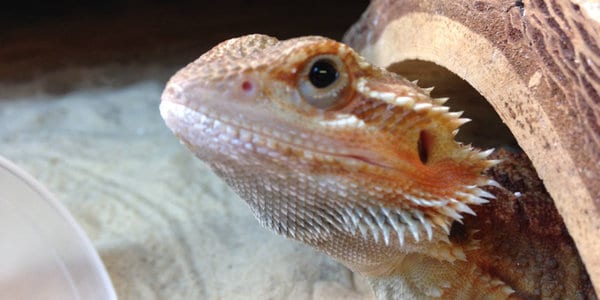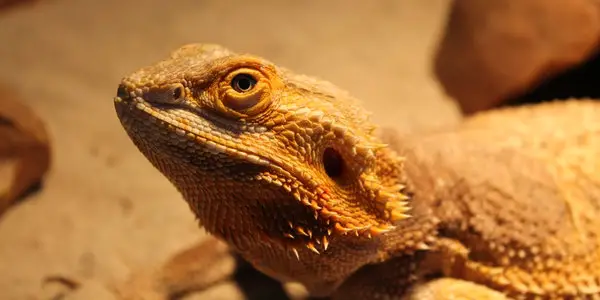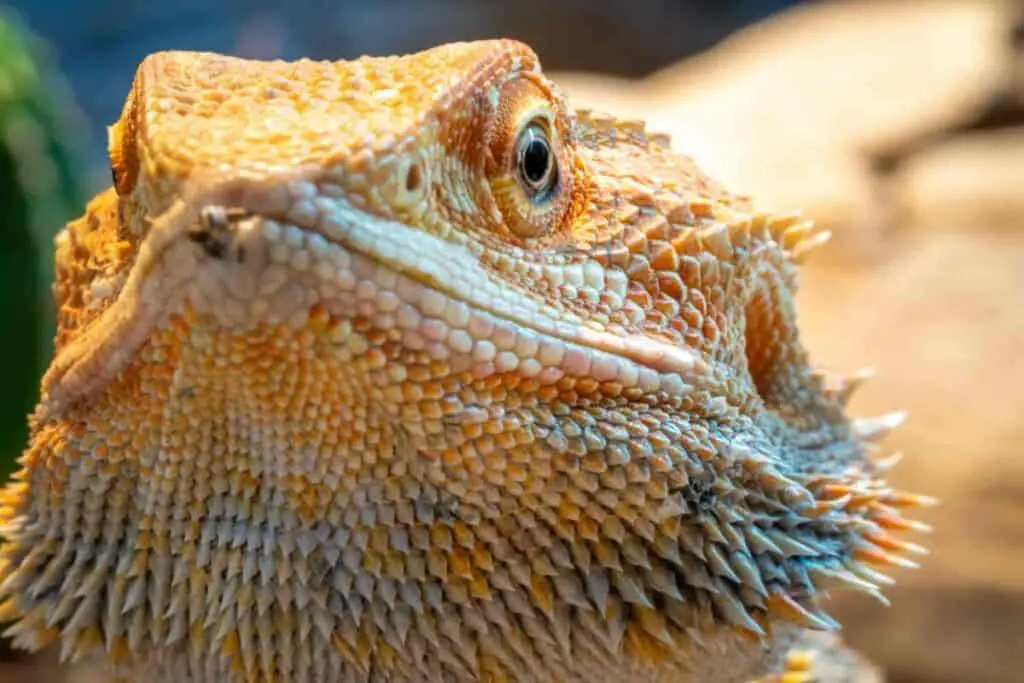Bearded dragons are fantastic pets. They are beautiful creatures, but they have an array of quirky behaviors and bodily functions that are often confusing. One aspect of bearded dragons that people often wonder about is their vision—especially how good they can see and what they can see.
Bearded dragons have excellent eyesight in most circumstances. Bearded dragons have eyes on either side of their head, providing them with a large field of view, and they have perfect vision at range. However, bearded dragons have poor depth perception, making jumps difficult.
Continue reading for a complete guide to bearded dragon’s vision. I’ll explain how bearded dragons see, what they can see and why their eyes work as they do. I’ll also go through some of the shortcomings of bearded dragon sight.

How Do Bearded Dragons See?
In order to properly care for a bearded dragon, you need to understand how your pet sees the world, both literally and figuratively. So what do bearded dragons see? And is their vision like ours, or does it function differently?
Bearded dragons primarily see through two eyes on either side of their head. They can see clearly, especially at a distance. However, as bearded dragons do not see objects with both eyes simultaneously, they are poor judges of depth perception, which may result in some falls.
Humans have excellent depth perception. Our brain combines the images given by both of our eyes and uses this information to paint a clear picture of how far away something is. The bearded dragon’s eyes do not see the same things simultaneously.
Instead, your bearded dragon sees from both sides of its head. This allows seeing more at one time with a large field of vision. However, as the dragon’s eyes see different images simultaneously, they cannot judge distances accurately.
You can see this shortcoming in your bearded dragon’s eyesight when they try to jump onto a branch or edge only to misjudge the leap spectacularly.
How Many Eyes Do Bearded Dragons Have?
Bearded dragons have three eyes. While bearded dragons mostly see through the two large eyes on the side of their heads, they also have a small, less capable eye on top of their head. This eye can’t see very much but is believed to sense changes in light and darkness.
The third eye on a bearded dragon can sense changes in temperature, shade, and lighting. This eye is used to detect changes in seasons and times of the day. However, the third eye on your dragon is unable to see images.
The third eye on your bearded dragon functions more like a sensor than a conventional eye.

Do Bearded Dragons Have Good Vision?
Bearded dragons do have good vision. Bearded dragons rely on their eyesight to make sense of the world and find food. Bearded dragons have a large field of view, and their sight has adapted to find and hunt insects and food sources in the wild.
The strengths in your bearded dragon’s eyesight lie in their ability to see items in the distance and their wide field of view. Bearded dragons evolved to have an excellent vision to source food in climates where food is scarce.
On top of this, bearded dragons are not on top of the food chain. In the wild, many predators will look for a bearded dragon to fill their bellies. As a result, bearded dragons need to be able to see threats coming from far away so they can run or hide to survive.
You’ll notice how good your bearded dragon’s vision is from far away if you carry their favorite food into the room they are in. They’ll see the food in your hand, and if they’re hungry, you will absolutely have their attention, even without showing them the food first.
Do Bearded Dragons See in Color?
Bearded dragons have a clear vision upon which they rely heavily to source food and assess threats. However, many animals rely on their eyesight but don’t see many colors, if any at all. Can bearded dragons see different colors?
Bearded dragons see in color. Bearded dragons rely heavily on their eyesight in the wild, and they use color vision to find food and detect threats. In fact, bearded dragons can even see ultraviolet light, which is invisible to humans.
Human beings can see in three colors as we have only three color receptors. Every other color that we see is just a combination of the three colors that we actually see. Bearded dragons, on the other hand, can see in more colors.
Bearded dragons are tetrachromatic, meaning that they see 4 different colors compared to the three that we see. As a result, they can see the world much differently from us, and they are capable of seeing things invisible to us.
Bearded dragons are also able to see UV rays. Ultraviolet rays come from sunlight, highlighting the importance of UV light for your dragon.
Do Bearded Dragons Enjoy Some Colors More than Others?
Bearded dragons do enjoy some colors more than others. Many bearded dragon owners have reported their pets interacting with certain colors, particularly bright reds. Bearded dragons may also hide from other colors like yellow; however, the colors they react to can differ between lizards.
Armed with this knowledge, you can find different colors your bearded dragon likes to interact with. This process will likely take some trial and error, but with some persistence, you will discover which colors pique your bearded dragon’s interest.
Adding colors that your bearded dragon enjoys is an excellent way of providing stimulation to your pet. This helps you create an ideal environment for your pet and promotes a long and happy life.

Can Bearded Dragons See Behind Them?
As humans, we can only really see in one direction at a time. We are constantly facing what we’re looking at with both eyes fixed forward. Bearded dragons have eyes on the side of their heads, offering a wider field of view. But can your bearded dragon see behind them when facing forwards?
Bearded dragons can see behind them. Your bearded dragon can watch over its shoulder behind them, even when facing forwards. Bearded dragons have such a large field of vision because their eyes are on the sides of their heads.
Bearded dragons have developed the ability to see behind them as a defense mechanism against predators. Bearded dragons live in deserts in the wild. As a result, they need to be able to keep an eye on wide-open spaces to see any potential threats coming from a distance.
They use their vision to evade predators as they can see front and behind.
Can Bearded Dragons See in the Dark?
Bearded dragons can’t see in the dark. The eyesight of bearded dragons has evolved into seeing during the day as this is when they are naturally active. In the wild, bearded dragons sleep during the night, so they have not developed eyesight for low light conditions.
Bearded dragons are diurnal animals. Humans are also diurnal, which means that you are awake during daylight hours. Diurnal animals generally have poor eyesight in dark conditions.
Nocturnal animals, on the other hand, are animals that are most active at night. Nocturnal animals have adaptations to their eyesight to see very well, even in the darkest of nights. An example of a nocturnal animal with excellent night vision is a cat.
Although bearded dragons can’t see in the dark, that doesn’t mean their natural habitat should be constantly lit. The lighting should follow the natural cycle of day and night.
Can Bearded Dragons See Their Reflections?
Bearded dragons can see their reflections, but they do not recognize themselves in them. Most bearded dragons will believe that their reflection is another bearded dragon. This may cause the dragon to attempt to flee or fight.
An animal’s ability to recognize its reflection is not dependent on its eyesight alone. In fact, testing an animal’s ability to recognize its reflections is used to determine intelligence and not vision. This is a test that most animals fail, with only the most intelligent capable of recognizing their reflection as themselves.
Since bearded dragons believe that their reflection is another lizard, and they’re solitary animals that don’t play well with others, there must be no mirrors or reflective surfaces in their enclosure. If your bearded dragon sees their reflection, it could become distressed or aggressive.
Key Takeaways
Bearded dragons are animals that rely heavily on their eyesight in the wild and in captivity. Your bearded dragon makes sense of the world with their excellent vision.
Bearded dragons are great at spotting threats and food from afar and have a wide field of view. They even have a third eye that detects changes in lighting and temperature.
While bearded dragons have excellent vision, they have relatively poor depth perception. This is why your bearded dragon misjudges leaps and bumps into objects.